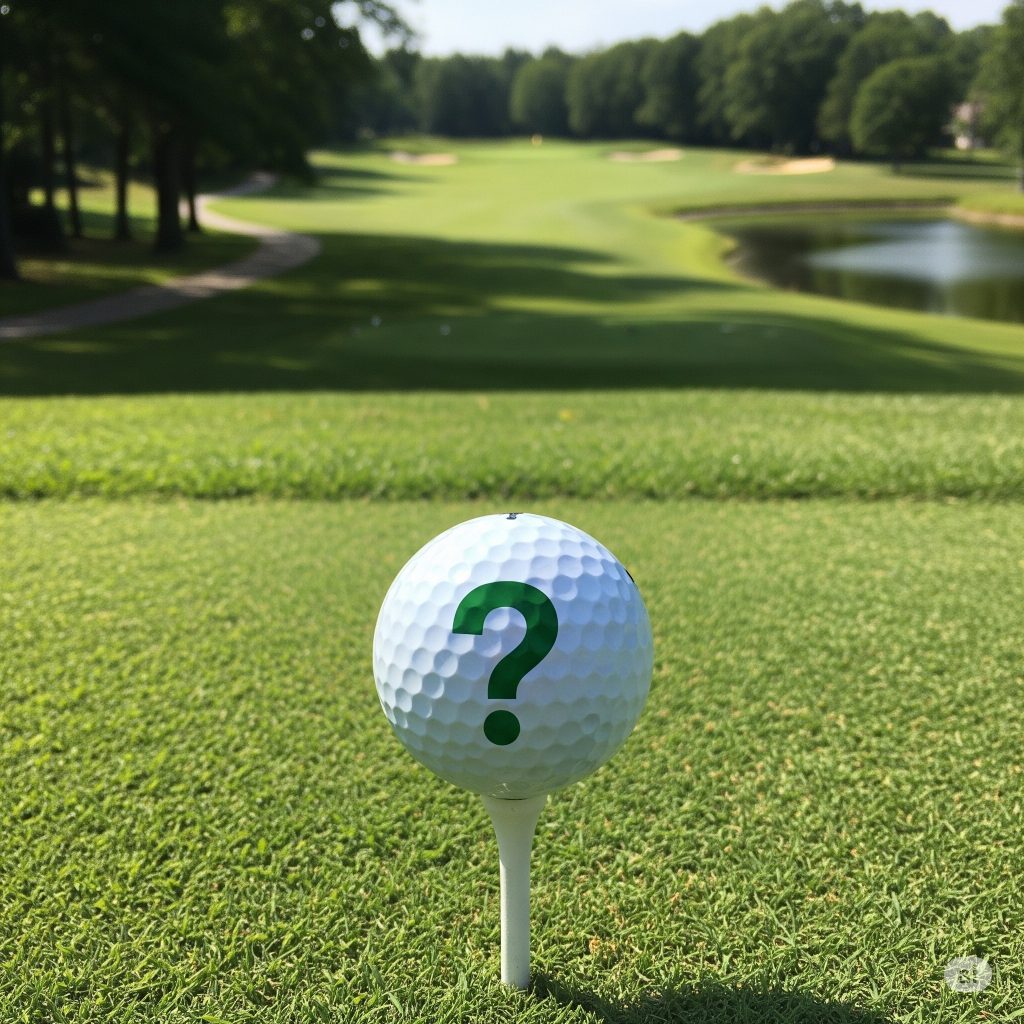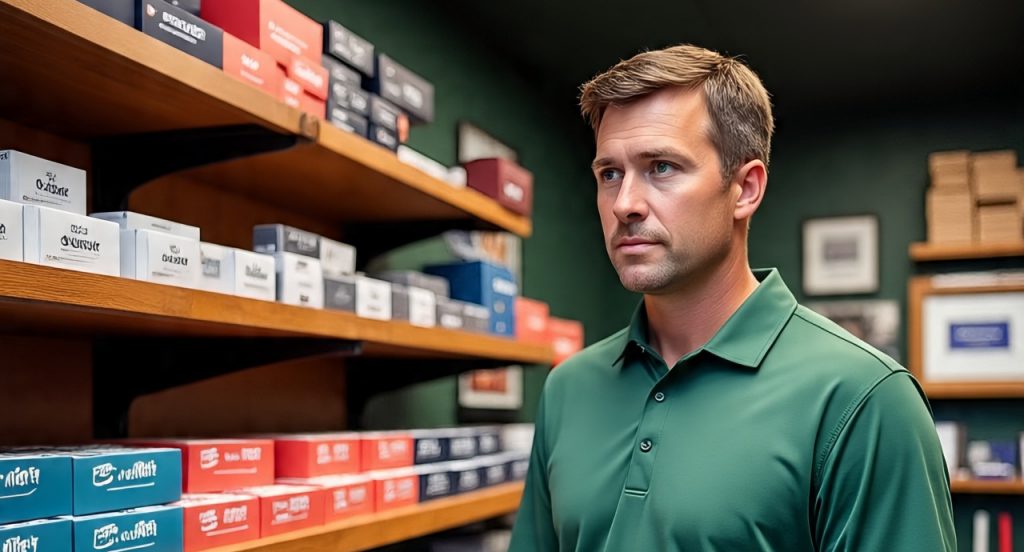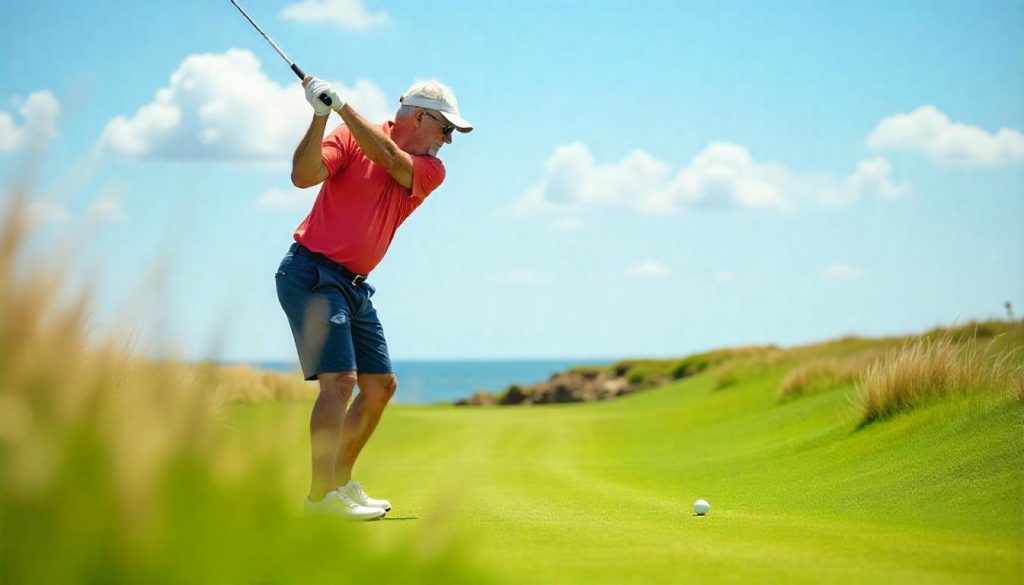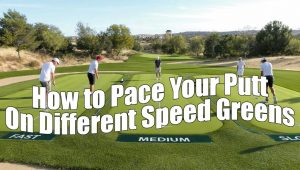(And Why a Pro V1 Might Be Killing Your Score)

Walk into any golf shop, and you’re hit with a wall of promises. A kaleidoscope of boxes, each one shouting about its “HyperElastic SoftFast Core,” “Speedmantle Technology,” or “Seamless Tour Flight Dimple Pattern.” It’s a confusing, overwhelming experience that leaves most of us asking the same question: what’s the difference, and which one is actually right for me? Faced with this paralysis by analysis, many golfers trying to choose the right golf ball do one of two things: grab the cheapest option or grab the one they see the pros playing on TV.
But what if I told you that both of those choices are likely costing you strokes? Is the golf ball you’re playing actually helping you, or is it secretly adding strokes to your score? This guide aims to help you figure out how to choose the right golf ball for your game.
To cut through the marketing noise and get to the truth, we did something different. We conducted a deep-dive analysis of a real amateur golfer’s game—a 24-handicapper just like many of us. To protect their privacy, we’ve anonymized their information, but the data, the struggles, and the potential for improvement are 100% real!
This case study will serve as our roadmap to help you choose the right golf ball for your game. This guide will provide a clear, step-by-step framework for understanding the DNA of a golf ball and matching it to your unique swing, ultimately helping you shoot lower scores.
The DNA of a Golf Ball: What Really Matters for Your Game
Before we can choose the right golf ball, we need to understand what makes them tick. Forget the fancy marketing terms for a moment. There are only four characteristics that truly matter for your performance: compression, spin, construction, and feel. Let’s break them down.
The Engine: Compression and Your Swing Speed
Think of golf ball compression as the engine of your performance. It’s a measure of how much a ball deforms or “squishes” against the clubface at impact, rated on a scale from about 30 (very soft) to 120 (very firm). Matching this rating to your swing speed is the single most important thing you can do to optimize your distance.
It’s like matching the shock absorbers to the weight of a car. Too soft, and it will bottom out; too firm, and it won’t absorb any impact. The same principle applies to your swing.
- Slower Swing Speeds (under 85 mph): You need a low-compression ball (rated 30-70). This softer construction allows the ball to compress more easily at your swing speed, creating a powerful “trampoline effect” that maximizes energy transfer. The result is higher launch and more distance.
- Moderate Swing Speeds (85-100 mph): You are best suited for a medium-compression ball (rated 70-90). This range offers a balanced blend of distance, feel, and control, effectively harnessing your power without sacrificing responsiveness.
- Faster Swing Speeds (over 100-105 mph): You require a high-compression ball (rated 90+). A softer ball would over-compress at your speed, leading to a loss of control and distance. A firmer ball holds its shape better, allowing you to translate your high speed into maximum velocity and a more controlled, penetrating ball flight.
Compression Theory a Myth?

Now, you may have heard chatter online or seen tests suggesting that this “compression theory” is a myth, and that firmer, premium balls like the Pro V1 are faster for everyone, regardless of swing speed. While it’s true that in a controlled lab environment, a high-compression ball might register a 1-mph higher ball speed off a robot, this completely misses the point of on-course performance.
Raw ball speed is only one piece of the distance puzzle. For an amateur golfer, the other, more critical factors are launch angle and spin. When a player with an 85-mph swing hits a high-compression Pro V1, they cannot properly compress the core. The ball feels like a rock, the energy transfer is inefficient, and the result is a low-launching, low-spinning shot that falls out of the sky too early. Even if the ball speed was technically a fraction higher, the poor launch conditions kill its carry distance. The goal isn’t just a high number on a launch monitor; it’s a high, powerful ball flight that maximizes carry and lands softly. To achieve that, you must compress the ball correctly. For the vast majority of amateur players, matching compression to swing speed is the fundamental starting point for unlocking playable distance.
Flight Control: The Two Faces of Spin
Spin is not a simple “good” or “bad” characteristic; it’s a tale of two very different requirements. The perfect golf ball for an amateur needs to be a master of disguise, acting as two different balls depending on the club you’re holding.
1. Driver Spin (The Slice Killer): For your long game, you want low spin. The primary engine of a slice or a hook is side spin. A ball designed to produce less spin off the driver will naturally reduce that damaging side spin, helping the ball fly straighter. Less curve means more fairways hit, fewer penalty strokes, and more yards from a more penetrating flight.
2. Wedge Spin (The Score Dropper): For your short game, you want high spin. This is the “bite” or “check” you see when pros hit shots that stop on a dime. High spin with wedges and short irons allows the ball to land softly and stop quickly, giving you the control needed to attack pins and get chips close to the hole. This is where scoring happens.
This creates an obvious dilemma: how can one ball be both low-spinning and high-spinning? You might have even heard the phrase “soft balls don’t spin,” which seems to contradict the need for a soft feel and high spin around the greens. This apparent contradiction is where modern golf ball construction works its magic.
In the past, with simple 2-piece golf balls, the properties were linked. The soft core that created low compression also produced low spin throughout the bag. But today’s advanced, multi-layer balls have decoupled these characteristics through a concept called spin separation.
Here’s how it works
A modern 3-piece ball has a large, soft inner core. When you hit it with a driver, the high-speed impact fully compresses this core, which is what reduces spin and helps you hit it long and straight. However, on a short wedge shot, the impact is much slower and doesn’t fully engage the core. Instead, the club’s grooves “grab” the ball’s thin, soft outer cover (typically made of a material called urethane). This interaction between the grooves and the soft cover is what generates massive amounts of spin for greenside control. This technology allows a single ball to be a low-spin distance machine off the tee and a high-spin scoring weapon around the greens—the holy grail for amateur golfers.
The Blueprint & The Feel: Construction and Cover Material
The final pieces of the puzzle are the ball’s physical construction and the material used for its cover. These elements dictate the ball’s ability to achieve spin separation and determine how it feels off the clubface.
Construction:
2-Piece Balls: These are the simplest design, consisting of a large, single core and a durable outer cover. They are generally built for maximum distance and durability, making them a great choice for beginners and high handicappers.
Their design typically leads to lower spin across all clubs.
3+ Piece Balls: These more complex balls add one or more “mantle” layers between the core and the cover. This mantle layer is the key component that helps the ball achieve spin separation, allowing it to react differently to driver impacts versus wedge impacts. They offer a more nuanced blend of distance, feel, and spin control.
Cover Material (The True Source of Feel and Spin):
The cover is the ball’s skin, and it’s the part your club actually touches. Its material is arguably the most important factor for scoring performance.
Ionomer/Surlyn: These are firm, highly durable, and less expensive materials. They are found on most 2-piece and “distance” focused balls. While great for longevity, they produce less spin on short shots and can have a “firm” or “clicky” feel.
Urethane: This is a much softer, more premium material. It’s the secret sauce behind the incredible greenside spin you see from Tour-level balls. The softness allows the club’s grooves to grip the ball more effectively on short shots, generating maximum spin and control. This is what provides that buttery-soft, responsive feel that better players demand.
While compression affects the overall feel of a full shot, the cover material is the single most important factor for improving your short game. If your biggest struggle is getting chips and pitches to stop on the green, your first filter when choosing a ball should be its cover. A ball with a urethane cover will have a more dramatic and immediate impact on your scoring than a ball that is simply a few points lower in compression but has a less-grippy Ionomer cover.
Case Study: Decoding the Needs of an Everyday Golfer

Now, let’s apply this knowledge to our real-world case study. Our player is a 50-some-year-old male with a 23.9 handicap. We estimated his driver swing speed to be in the 85-90 mph range based on his provided club distances. He selected the Fairway Fundamentals MAX Strategy Guide because he wants to know how to choose the right golf ball and new bag of clubs.
Let’s translate his on-course struggles into specific equipment needs and help him choose the right golf ball for him
Problem Analysis and Solution
| Problem | Need |
|---|---|
| He describes his driving as “all over the course,” with wide misses and a low Fairways in Regulation percentage. | A low driver spin golf ball. This will reduce the damaging side spin that causes his big misses, promoting a straighter, more predictable ball flight and helping him find more fairways. |
| He has a very low Greens in Regulation (GIR) percentage; he frequently sees his approach shots land on the green only to roll off the back or side. | A ball with moderate-to-high iron spin. Sufficient backspin on approach shots creates a steeper angle of descent, helping the ball land more softly and stop more quickly on the green. |
| His Strokes Gained data shows huge losses around the green, and he has a high number of putts per round. His short game is his biggest weakness. | A ball with high short game spin and a soft feel. This will give him the stopping power to get chips and pitches closer to the hole, and the responsive feel will provide better feedback for controlling distance on these delicate scoring shots. |
Based on this analysis, we can build a “wish list” for his perfect golf ball:
- Compression: Low-to-Mid (ideally 60-80) to perfectly match his estimated 85-90 mph swing for maximum distance.
- Construction: A 3-piece ball to enable the critical spin separation between his driver and wedges.
- Cover: A Urethane cover (or a high-performing hybrid with a urethane coating) to deliver the greenside spin he desperately needs to lower his scores.
- Feel: A soft feel to provide confidence and better feedback on and around the greens.
The Best Golf Balls for Amateur Players: Your 2025 Shortlist
With a clear profile of our player’s needs, we can now confidently navigate the market and make specific, justified recommendations helping him choose the right golf ball for his game & wallet.

The All-Around Champions: The Rise of the “Amateur Tour Ball”
For years, golfers had to make a compromise: choose a soft, 2-piece distance ball that was forgiving off the tee but lacked greenside control, or play a firm, expensive Tour ball that spun great but was difficult to compress and unforgiving on mishits. Today, that compromise is no longer necessary.
A new category has emerged that is perfectly suited for our case study player and millions of other amateurs: the “Amateur Tour Ball.” These balls are the ultimate sweet spot. They combine the low-to-mid compression and soft feel that amateurs need with the multi-layer construction and urethane cover they crave for short-game performance. They are, in effect, perfectly “de-tuned” Tour balls, offering the best of both worlds.
What We Recommended
Primary Recommendation: Callaway ERC Soft
The Callaway ERC Soft is the poster child for this category and the ideal fit for our player. Its compression rating of 70 is squarely in the sweet spot for an 85-90 mph swing, ensuring optimal energy transfer. Its 3-piece construction features a high-speed mantle and a GRIP Urethane Coating, a combination designed to deliver the exact spin separation he needs: low spin off the driver for accuracy and high spin with the wedges for control. To top it off, it’s renowned for an incredibly soft feel, providing the feedback and confidence required for a better short game.
Alternate Champion: TaylorMade Tour Response
The TaylorMade Tour Response is another outstanding example of an “Amateur Tour Ball” and a fantastic alternative. It shares a nearly identical DNA with the ERC Soft: a 70-compression rating, 3-piece construction, and an exceptionally soft feel. Its key feature is a 100% cast urethane cover—the same material found on TaylorMade’s premium TP5 balls—which is designed to provide ample spin and control on all shots into and around the green. It’s a ball that delivers Tour-level feel and short-game performance without requiring Tour-level swing speed (or price).
The Forgiveness Kings: Maximum Distance, Minimum Curve
For some players, particularly beginners or those who struggle mightily off the tee, the number one priority is simply keeping the ball in play and maximizing distance. For these golfers, a 2-piece ball focused on forgiveness and a straight flight is often the best choice, even if it means sacrificing some of that premium greenside bite.
Recommendation 1: Srixon Soft Feel
With a low compression of 60 and a 2-piece Ionomer cover, the Soft Feel is engineered for one primary purpose: to fly straight. It’s an excellent choice for players with slower swing speeds (under 85 mph) who need to tame a slice and want an incredibly soft feel at an affordable price.
Recommendation 2: Callaway Supersoft
The Callaway Supersoft is a legend in this category for a reason. With an ultra-low compression rating of just 38, it’s one of the softest balls on the market and is designed specifically to help golfers with slow swing speeds maximize their distance. If you need help getting the ball in the air and down the fairway, the Supersoft is a fantastic and very popular option.
Recommendation 3: Titleist Tour Soft
The Titleist Tour Soft is a fascinating ball that bridges the gap between categories. While it has a 2-piece construction and an Ionomer cover, it has been engineered to produce surprisingly high spin on iron and wedge shots—spin levels that rival some urethane models. This makes it a unique value proposition for the player who wants excellent control on approach shots without paying the premium for a full-blown urethane ball.
Quick-Glance Guide: Top Golf Balls for the Amateur Player
To help you compare these excellent options, here is a quick guide summarizing their key characteristics and ideal player profiles.
| Golf Ball | Construction | Cover Material | Compression (Feel) | Ideal Player Profile |
|---|---|---|---|---|
| Callaway ERC Soft | 3-Piece | Hybrid (Urethane Coat) | 70 (Incredibly Soft) | The amateur wanting a soft feel with Tour-level greenside spin. |
| TaylorMade Tour Response | 3-Piece | 100% Urethane | 70 (Exceptionally Soft) | The player seeking premium short-game control without needing Tour speed. |
| Srixon Soft Feel | 2-Piece | Ionomer | 60 (Incredibly Soft) | Slower swing speeds (<85 mph) prioritizing straight flight and soft feel. |
| Callaway Supersoft | 2-Piece | Hybrid | 38 (Super Soft) | Beginners and slower swingers who need maximum help with distance. |
| Titleist Tour Soft | 2-Piece | Ionomer | 67 (Soft) | The player who wants excellent iron/wedge spin without a urethane price. |
| Wilson Staff Duo Soft+ | 2-Piece | Surlyn | 37 (World’s Softest) | The ultimate choice for feel, or for cold weather performance. |
| Bridgestone e6 | 2-Piece | Surlyn | 50 (Soft) | Moderate swingers seeking a straight ball flight and reduced side spin. |
(We should add here that our Fairway Fundamentals Strategy Guide with the Golf Ball Fitting option outlines all of the information above tailored to your game and your swing characteristics, and it also includes additional information analyzing the correct ball to play in different weather conditions such as heat (< 90°F / 32°C), cold (<50°F / 10°C), or rainy / wet weather.
Click “Request This Report” below, choose the next available “tee time”, complete the stats questionnaire it will send you, and we’ll start crunching your numbers)
The Tour Ball Trap: Why Playing a Pro V1 Could Be Hurting Your Score
We have to address the elephant in the room: the Titleist Pro V1, TaylorMade TP5, and other premium “Tour” balls. We see our heroes on TV using them to win majors, so it’s natural to assume that “best for them equals best for me“. For the vast majority of amateur golfers, this is the single most common and costly equipment mistake they can make.
Let’s look at the facts: A Titleist Pro V1 has a compression rating around 90-104, and a TaylorMade TP5 is around 85. For our case study player with an 85-90 mph swing, these balls are far too firm. Playing them leads to a cascade of negative consequences:
- A Significant Loss of Distance: As we discussed, he cannot properly compress the core. This leads to a harsh, “dead” feel off the clubface and a suboptimal launch, robbing him of precious carry distance.
- Exaggerated Misses: These balls are engineered for high spin to allow elite players to shape their shots. For a player who already fights a slice, this high-spin design is a nightmare. It will only amplify his side spin, turning a playable fade into a banana ball that dives into the trees. A low-spin ball would help straighten his shot; a high-spin Tour ball will make it curve more.
- Wasted Money: These are the most expensive golf balls on the market, often costing upwards of $55 / £41.50 / €47.70 per dozen. A mid-to-high handicapper is paying a massive premium for technology that is actively working against their golf swing.
Conclusion: Your Action Plan to Find the Perfect Match
Choosing the right golf ball doesn’t have to be a guessing game. By understanding the core principles of performance and getting an honest assessment of your own game, you can make an informed decision that will lead to more distance, better control, and lower scores.
Let’s boil it all down to a simple action plan:
1. Match Your Engine:
Your number one priority is to match the ball’s compression rating to your driver swing speed. This is the foundation of optimal distance.
2. Prioritize Your Weakness:
If you lose the most strokes around the green, make a urethane cover a non-negotiable. It is the single biggest technological advantage for improving your short game.
3. Embrace the “Amateur Tour Ball”: For the best all-around performance, look for a 3-piece ball with a mid-range compression (around 70) and a urethane cover. This category is designed for you if you match our case study.
4. Avoid the Tour Ball Trap:
Stop spending your hard-earned money on premium Tour balls that are too firm for your swing and will only exaggerate your misses!
A Challenge for You
Now for the final, most important step. No blog post or video can be a perfect substitute for real-world testing. Based on the profiles in this guide, it’s time for you to put the research to the test.
Here’s your challenge: Select two different balls from our list that you think fit your game. Buy one sleeve of each. Go to your home course and play the front nine with the first ball and the back nine with the second. Pay close attention. How does it feel off the driver? Does it hold the green with your 7-iron? How does it react on a 30-yard pitch shot?
By the 18th green, you’ll have your answer—one that’s backed not just by expert data, but by your own experience. You’ll have found your perfect match, and you’ll be on your way to playing smarter, more enjoyable golf! Good luck out there!
This post contains affiliate links. If you use these links to buy something, I may earn a commission at no extra cost to you. Thanks for your support!

0 Comments